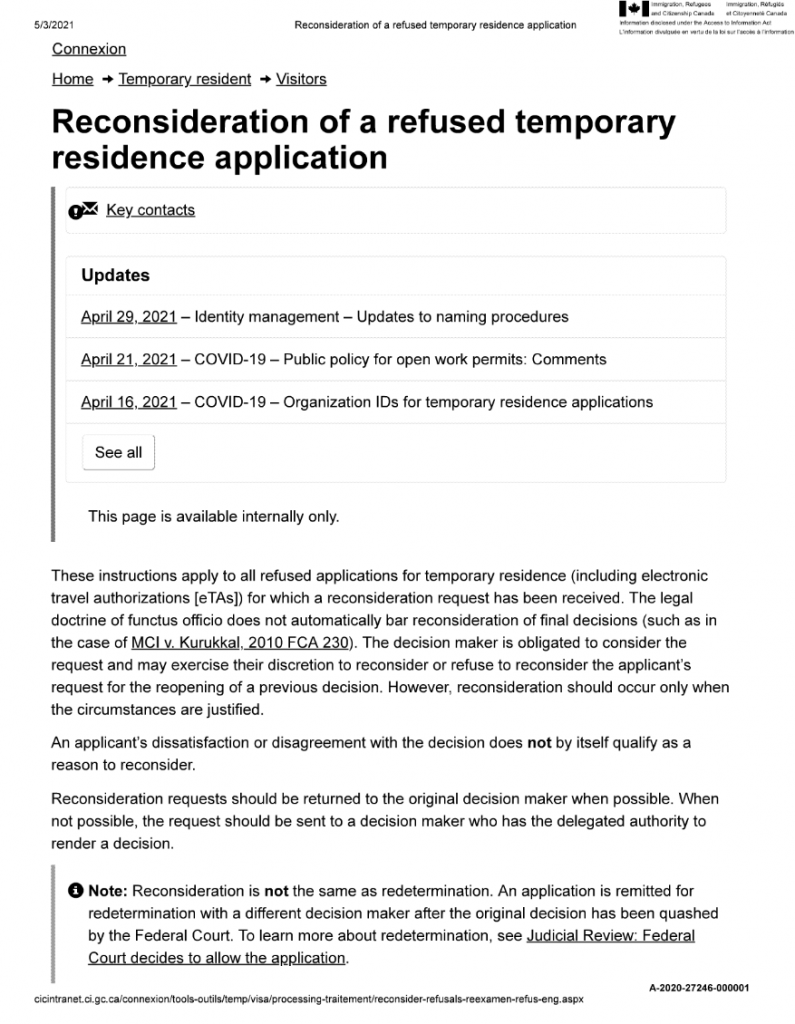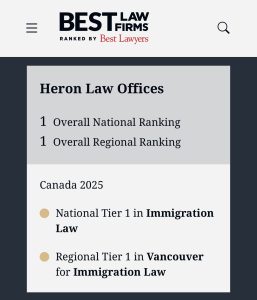One of the most underappreciated and underutilized remedies in Canadian immigration is that of the reconsideration request.
I do not blame advisors or applicants for this one. This is a general veil on what this remedy entails – especially as the existing policy guidance and materials are not presented as general instructions, rather specific to application types (Humanitarian and Compassionate Grounds and Family Class). Finding the right information on IRCC’s website is a bit of a treasure hunt.
A. What We Know To-Date
We know that a reconsideration request is a written request to an officer to ask them to reconsider a decision. These are often sent in through case-specific enquiry or to a visa-office supported method of communication.
The main instructions, which *in large part* represent present day instructions, are found below in my breakdown of the H&C and Family Class program delivery instructions (“PDIs”). I have quoted the instructions and will add some commentary as I discuss throughout.
H&C PDIs
These first set of instructions are from the Humanitarian and Compassionate Grounds PDIs.
Guidelines for reconsideration requests after refusal (at stage 1 or 2)
The legal doctrine of functus officio does not automatically bar reconsideration of final H&C decisions (MCI v. Kurukkal, 2010 FCA 230). The decision maker may exercise discretion to reconsider, or refuse to reconsider the applicant’s request for reopening of a previous decision. However, reconsideration should only be done in exceptional cases.
An applicant’s dissatisfaction or disagreement with the decision does not by itself qualify as an exceptional case.
Return reconsideration requests to the original decision maker when possible. For reconsideration requests previously determined by a local CIC, the request should be sent to BRO-V for assignment.
(emphasis added)
I want you to pay extra careful attention to the words underlined for emphasis added.
IRCC then goes to set out a two-step process for reviewing a consideration request. As a side note here, I rarely ever see counsel go through the two-part test or highlight the considerations below.
Reviewing a request for reconsideration is a two-step process:
- Decide whether to re-open the case and consider the new evidence, even if the case is under litigation at the Federal Court.
- If you decide to reconsider, review the new submissions and the original file and decide whether or not to change the original decision.
The factors for reconsideration are set out below:
Factors to consider when deciding whether to reconsider:
You must first determine whether a reconsideration of a previous H&C decision is warranted based on the information submitted. The onus is on the applicant to satisfy the officer that the reconsideration should be done. You should consider all relevant factors and circumstances to determine whether a case merits reconsideration. The following is a non-exhaustive list of factors that may be relevant to consider:
- Whether the decision-maker failed to comply with the principles of natural justice or procedural fairness when the decision was made.
- Whether the applicant has requested correction of a clerical or other error (e.g. a decision was made by an officer who did not have the delegated authority).
- If new evidence is submitted by an applicant, is the evidence based on new facts (i.e. facts that arose after the original decision was made and communicated to the applicant) and is it material and reliable. Decide whether that evidence would be more appropriately considered in the context of a new application.
- When additional evidence is presented that was available at the time of the original decision, consider why it was not submitted at the time of the original application. Determine whether that evidence is material and reliable.
- The passage of time between the date of the original decision and the date of the reconsideration.
- Whether there were any concerns regarding fraud or misrepresentation relating to a material fact, in the original decision or with the new submissions.
- If there is a negative decision from the Federal Court after judicial review, you may refuse to re-open if there are no extenuating factors to warrant reconsideration.
(emphasis added – note this one particular last bullet point moving forward)
IRCC also provides guidance to Officers in the public facing instructions about what to do after deciding whether to reconsider or not reconsider.
Once you have decided whether or not to reconsider:
If the decision is to reconsider do the following:
- re-open the first H&C decision
- request information from the applicant (e.g. medical, procedural fairness letter)
- make a new decision and send approval/refusal letter Stage 1.
If the decision is not to reconsider notify the applicant. You may refer to the original refusal to explain the refusal because the applicant was already informed of the reasons that their application was refused.
Record the reasons why the reopening request was granted or refused based on the submissions reviewed. For example, a decision might reflect the following reasons: passage of time, new information not previously submitted, or procedural fairness error. Whether a detailed analysis is necessary should be determined on a case-by-case basis depending on factors such as whether the decision was re-opened, the kind of submissions etc.
Family Class PDIs
With respect to the Family Class, IRCC has the following instructions.
Much of which replicates what is listed in the H&C section above:
Reconsideration and enquiries after refusal
Applicants or their representatives often submit information after a refusal and request that an officer reconsider the decision. If an office receives a request to reconsider a decision, an officer must consider the request and decide whether or not to exercise their discretion to reconsider the previous decision. The legal doctrine of functus officio does not automatically bar reconsideration of final decisions (MCI v. Kurukkal, 2010 FCA 230).
The decision-maker may exercise discretion to reconsider, or refuse to reconsider the applicant’s request for reopening a previous decision. However, reconsideration should only be done where warranted, in exceptional cases. An applicant’s dissatisfaction or disagreement with the decision does not by itself qualify as an exceptional case.
The onus is on the applicant to satisfy the officer that reconsideration is warranted. The decision-maker should consider all relevant factors and circumstances to determine whether an application merits reconsideration. The decision whether or not to reconsider the application must be recorded in GCMS and communicated to the applicant. The applicant’s correspondence requesting reconsideration and any supporting documents should be kept on file.
(emphasis added)
Noting again, the underlined sections, one wonders why for Family Class, the information is different than that for H&C grounds. Based on these instructions it appears the Officer MUST consider the reconsideration request, but MAY choose to exercise discretion to re-open or not to re-open. Again, the wording is of EXCEPTIONAL CASE.
The factors are then listed below, which largely replicate the one for H&C.
A (non-exhaustive) list of factors that may be relevant to consider:
- whether the decision-maker failed to comply with the principles of procedural fairness when the decision was made
- whether the applicant has requested correction of a clerical or other error (e.g. a decision was made by an officer who did not have the delegated authority)
- if new evidence is submitted by an applicant, is the evidence based on new facts (i.e. facts that arose after the original decision was made and communicated to the applicant) and is it material and reliable. Decide whether that evidence would be more appropriately considered in the context of a new application
- when additional evidence is presented that was available at the time of the original decision, why it was not submitted at the time of the original application – determine whether that evidence is material and reliable
- the passage of time between the date of the original decision and the date of the reconsideration
- whether there were any concerns regarding fraud or misrepresentation relating to a material fact, in the original decision or with the new submissions
It is preferable that the initial decision-maker review any request for reconsideration. However, where that is not possible, a request for reconsideration can be reviewed by a different decision maker as long as that person has authority to make decisions of the type under review.
The one noticeable omission is this factor from above:
- If there is a negative decision from the Federal Court after judicial review, you may refuse to re-open if there are no extenuating factors to warrant reconsideration.
Finally the instructions provide the Officer to enter information into GCMS.
Officers making a decision on whether or not to reconsider should ensure that the following information is entered in GCMS Notes:
- the reconsideration decision
- the reasons for the reconsideration decision
Note: The decision whether or not to reconsider is subject to the possibility of judicial review. Taking the above measures will ensure that, in the event a refused applicant submits a leave to appeal to the Federal Court, there is an official record and supporting information on file to reflect that IRCC received, assessed and rendered a decision on a reconsideration request.
Reconsideration for Paper-Based Applications
IRCC also has some instructions posted in program delivery instructions titled: Emailing clients who have paper-based applications which cross-references the Family Class instructions, suggesting again that these are the main instructions.
Missing Emails Cases
There is also specific information regarding missing email cases, which I will not go into detail, you can find more information here on the same PDIs for Paper-Based applications discussed above.
These instructions replace the expired Operation Bulletin 195 and have remained consistent throughout.
B. What Do Current Instructions Not Tell Us?
However, what about regular temporary residence applications (student permits, work permits, visitor visas, and eTAs?
Do the same instructions apply?
Are there are also other instructions that are missing? For example for economic applications. Why is the information on reconsideration only for two programs.
I decided to do an ATIP request on reconsiderations to find out. Note – I still do not believe I received all the information I was seeking, specifically how different overseas visa offices create policies and practices around reconsideration. However, I did get some training materials and updated information that will highlight discrepancies. It also highlights the challenges of navigating updated policy from a bureaucratic perspective.
Most of IRCC’s policies (unless they are designated as internal – as this one was) are ultimately converted into the Program Delivery Instructions (PDIs) for the broader public. As the internal materials are updated, the external ones do not always follow suit. There can be discrepancies. In this case, we have access to a policy guide that is not currently public.
I hope by posting this IRCC will amend their outward looking instructions so that those who make reconsiderations in the uncovered areas have policy to follow and similarly, from a judicial review perspective, Courts are able to at least tie refusals to posted policy rather than extrapolate from other areas, as we currently must do.
What We Have Learned With This Latest Access to Information Release
I am attaching a copy of the ATIP results below. If you would like an email copy or the download is not working please shoot me an email at will@heronlaw.ca
Download link via Google Drive: here
[1] IRCC Has Not Made the Reconsideration of a Refused Temporary Residence Application Publicly Available
One might ask why this is? It is listed on the front page: ‘This page is available internally only.’ My best guess is that given the volume of temporary residence applications, and the possibility of floodgates if instructions or a webpage were made available for the many that are necessarily refused that this would cause an issue. Still – note this.
[2] The Public Does Not Always Get the Latest Instructions
The H&C reconsideration instructions are from 2014 while the Family Class ones are from 2019. This latest internal instruction was modified on 09 December 2020. What we may be relying on from public materials (i.e. trying to apply the Family Class or H&C reconsideration principles to our study permit refusal reconsideration cases) could actually be relying on outdated policy.
[3] There are Subtle but Key Discrepancies Between the New Instructions and Currently Posted Instructions
Just as I pointed out the discrepancy between the H&C and the Family Class (likely due to the five-year gap in updates), the one for temporary residence, including eTAs, is also different.
It clarifies that the instructions for the Family Class, not the H&C, are the correct ones although it replaces the word MUST with OBLIGATED.
It is also interesting to note that the EXCEPTIONAL wording of the Family Class and H&C outward facing instructions are replaced by a much more tempered ONLY WHEN THE CIRCUMSTANCES ARE JUSTIFIED.
It is also interesting to note the language from the H&C factor, which is missing from the Family Class section – re-appears
“if there is a negative decision from the Federal Court after judicial review, the option of refusing to reopen the decision if there are not extenuating factors to warrant reconsideration.”
This suggests that this factor likely should also be in the Family Class instructions.
[4] There are Alternatives to the Webform, but I am Not Sure If We’re Supposed to Know This.
On page 2 of the PDF, there is a list of Reconsideration contact information, varying from emails for the Domestic Network (DN) to the Centralized Network (CN): Operational Support Centre (OSC), to Case Processing Centre Ottawa, to Case Processing Centre Edmonton. These are emails that I have not generally seen, so it is likely that the Webform filters this. Given the webform inquiries take awhile, I am not sure if my practice will be to directly email the requests to these particularly emails – but it is worth knowing.
[5] Appendix JJ – Reconsiderations – Seems to Restrict Scope of Reconsideration
Appendix JJ, which appears to come out of a longer training guide, makes clear that any information received at a the decision has been made is not acceptable as a general rule, but that exceptions to this process are to be made on a case by case basis.
Given new evidence is a factor, it is not surprising that this would create some confusion.
if new evidence is submitted by an applicant, is the evidence based on new facts (i.e. facts that arose after the original decision was made and communicated to the applicant) and is it material and reliable. Decide whether that evidence would be more appropriately considered in the context of a new application
The example given suggests that the new evidence was accepted only as a result of a clerical error on IRCC’s end and that the client trying to correct it, is not a ground for reconsideration. I know from my own personal experience that exceptions can be made for these type of issues, so it is surprising that the training provided by IRCC suggests otherwise.
Another factor that is not publicly known that this Appendix reveals, is that in the case of an R.10 IRPR rejection (for incompleteness), IRCC is to look for other completeness issues to justify the continued decision to send back the application.
Again, this is not well-known policy but probably should be made public so applicants know.
[6] The Central Intake Training Guide is a Carbon Copy of the Paper-Based Application PDIs
In the release package, on pages 8-9 you will see the training materials that Officers presumably receive for Centralized Intake (last dated January 2020) is the same as the Paper-Based Application PDIs. A large portion of the missing email reconsideration cases also shows up in this document. However, from the training material, there is no mention of the context of the training being for paper-based applications. The fact that crucial instructions are buried in a section that is itself becoming less relevant to general immigration processes that are moving primarily electronic suggests some reorganization of where reconsideration program delivery update instructions are found (ideally as a separate page) should be done.
C. MY ASK: Send Me Your Reconsideration Global Case Management System (“GCMS”) Notes
I have an ask for fellow counsel and practitioners. For both ATIPs you file when reconsideration requests are rejected and approved (frankly, I don’t do enough ATIPs on cases with positive outcomes) please share me client-confidentiality redacted versions of those notes. I am trying to better study the process of reconsideration, especially from overseas decision-makers.
I have heard numerous rumours (yet to be substantiated) that refusals at certain visa offices are the gatekeeper and that reconsideration requests are often approved. Such an unwritten policy, based on IRCC’s stated policy, would seem inconsistent. I am still seeking information as well on reconsideration approval rates, but have had less luck obtaining them.
With your help I look forward to putting on a workshop on this issue in due time.
Hope everyone enjoyed this mini-deep dive into reconsideration requests.





